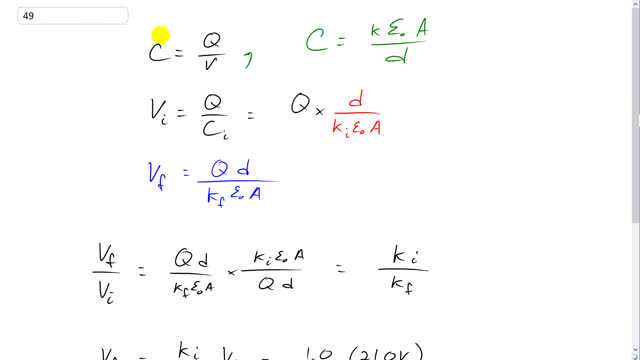
An uncharged capacitor is connected to a 21.0-V battery until it is fully charged, after which it is disconnected from the battery. A slab of paraffin is then inserted between the plates. What will now be the voltage between the plates?

In order to watch this solution you need to have a subscription.
This is Giancoli Answers with Mr. Dychko. Capacitance is the amount of charge that can be accumulated on each plate per volt. So, Q divided by V and we can rearrange this for V by multiplying both sides by V over C and you get V is Q over C. So initially before the paraffin is inserted between the plates we have the initial is Q divided by C initial but the capacitance has a formula dielectric constant times permittivity of free space times the area of the plates divided by the separation. So if we gonna use Q divided by capacitance, We can also go Q multiplied by the reciprocal of the capacitance. So that's Q times d over initial dielectric constant times Epsilon naught times area and the final voltage after the paraffin is inserted is gonna be Q d divided by the final dielectric constant times Epsilon naught A. So everything else is the same. The only thing that's changed about this capacitor is the dielectric material, so we need a different dielectric constant. So we have the final voltage divided by the initial voltages, Q d over k f Epsilon naught A. And then multiply by the reciprocal of the initial voltage is the same as dividing by it. And then that's gonna be K initial times Epsilon naught A over Q d and everything cancels here except for the dielectric constants so we have V f over V i equals k i over k f and then multiply both sides by V i and you get the final voltages k i over k f times initial voltage. So the initial dielectric constant is one because we assume that it's air separating the plates initially and divide that by 2.2 dielectric constant of paraffin times by 21.0 volts and you get a new voltage of 9.5 volts so because you've increased the dielectric constant between the two plates you can get the same charge accumulated on the two plates with less voltage now, only 9.5 whereas before you need 21.